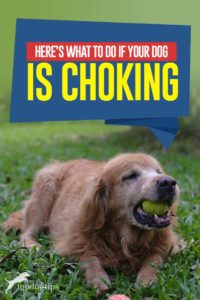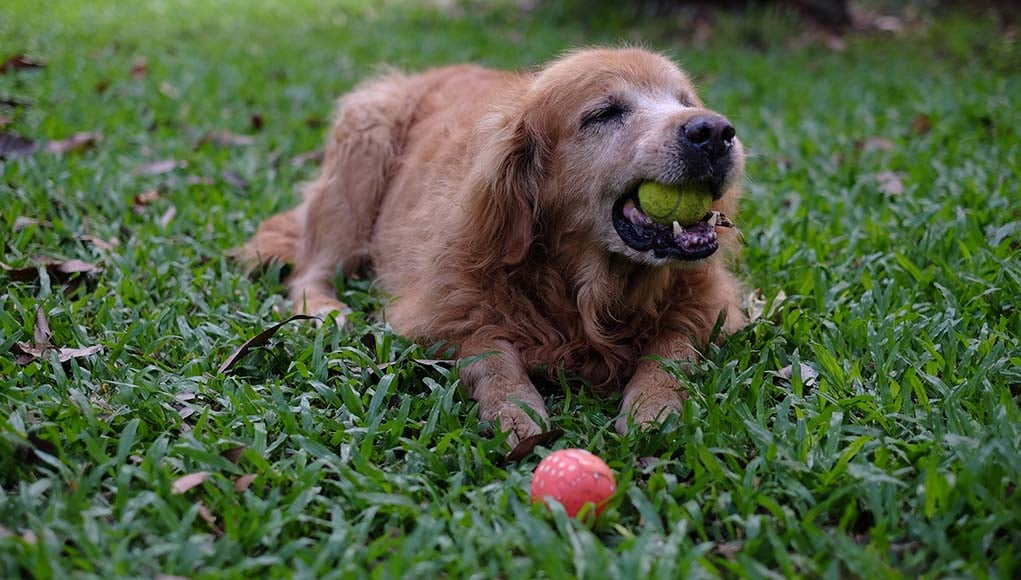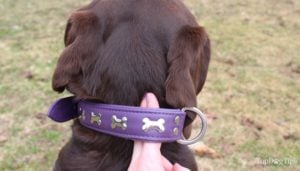Our dogs are like children. They like to put different objects in their mouth and chew them or swallow them, which may result in choking. Dog's air vents get blocked, it deprives the body and brain of oxygen, and could potentially be fatal. It should always be treated as an emergency in which every moment counts. This is why you need to know how to recognize the symptoms, what can cause it and what to do if dog is choking.
What Causes Choking in Dogs Most Often?
In dogs, choking is most usually caused by a foreign (inedible) object being stuck in their throat and preventing them either partially or completely from breathing (medically known as dyspnea).
 The most common objects which the dog will try to swallow are balls and toys. Dogs choke on the things that are too small to fit into their mouth, but too big to fully swallow. Even if you buy only toys which are bigger than your dog's mouth, it's possible they'll rip them apart or split them into smaller pieces.
The most common objects which the dog will try to swallow are balls and toys. Dogs choke on the things that are too small to fit into their mouth, but too big to fully swallow. Even if you buy only toys which are bigger than your dog's mouth, it's possible they'll rip them apart or split them into smaller pieces.
Other dangerous objects for dogs are bones. Even though your dog likes them, it doesn’t mean they are not dangerous. Cooked bones are more likely to cause choking as they are bendable, softer and prone to splitting into pieces.
There are also choking accidents which involve something being wrapped up around your dog’s throat such as a collar. While running around, the collar buckle may caught into or onto something like bushes, branches, fence, or even another dog’s collar. This also has a choking effect and prevents the dog from breathing.
How to Recognize Choking Symptoms?
If your dog is choking, he will cough constantly or try to vomit but without anything coming from his mouth. He will have difficulty breathing and swallowing. You will recognize it easily, because the dog will be in distress, frightened, disoriented; they will whine or snarl, and might even come to you expecting help.
If the foreign object is stopping the air completely, they might feel dizziness and collapse.
However, Banfield vets warn that it's more rarely for dogs to be actually choking but instead they may be suffering from respiratory issues or other breathing problems, such as infections, injuries to the throat or a collapsing trachea (rare, and usually in small old dogs only) that do not always require emergency procedure but need immediately veterinary attention.
What to Do If Dog Is Choking?
Every choking accident includes a veterinarian. There are things you can do to help your pooch on the spot by removing the objects or allowing them to breathe, but even if you manage to do that, your pet will need a check-up with a professional afterward.
If you notice that your dog is choking – limit their movements. Choking is a frightening experience and the dog will try to take the object out by rubbing their head against the walls and floor, or by stretching their body or making mimics similar to yawning.
Carefully, look into the dog's throat to check if you can see an obstruction. If it’s not easy to spot, go gently over their mouth with your fingers – this is called “performing a finger sweep”. If you find the object, you can first try to gently sweep it toward the center to remove the object, or then try removing it with pliers or tweezers (VIN warns not to accidentally damage your dog's Adam's apple). In case it is something big which can be broken, you can also try to break it into smaller pieces.
Don’t be surprised if your pooch tries to bite you if you start going down into their throat with your hand. This is why it is important to put a piece of cloth over his teeth before trying to take out the object.
Avoid pushing the object downwards towards the stomach, because that can only worsen the situation. If the object is not too big, the chances are that your pup is still getting some air, but if you push it too far, you can completely cut out the air supply.
Vets also suggest exercising pressure with your fingers on the bottom of your dog’s jaw, near the throat, and pressing forward as if you want to squeeze something out. Also, when your dog is choking but is conscious and there's still air coming through, they might also be getting overheated. In that case, before you run to the vet's office, cool your dog with cold water applied to their ears, feet and belly – then get to the vet.
And in the case that the dog is choking due to a collar accident, try to calm them down and cut it with scissors or a knife. Your dog may be panicking and moving a lot, so be careful to not accidentally cut the dog or stick him with the sharp edge.
Heimlich Maneuver for Dogs and Rescue Breathing
 Probably the most efficient technique for saving your dog from choking if he has swallowed something is the Heimlich maneuver. When doing Heimlich for dogs, you should apply this technique in accordance with the dog’s size and the position he is in.
Probably the most efficient technique for saving your dog from choking if he has swallowed something is the Heimlich maneuver. When doing Heimlich for dogs, you should apply this technique in accordance with the dog’s size and the position he is in.
If you have a small dog, hold him next to you with his back in line with your stomach. Put your fist in the upper part of his stomach, just under the ribs. Then you push with your fist towards his stomach and upwards. Repeat this process several times.
If you have a large dog, do not try to lift them, because this can cause more harm than good. If the dog is standing, make a hugging position around his belly, and press the part below his ribs several times. If he is lying down, turn him slightly to the side and lie next to him and then perform the pressing abdomen procedure while pressing with your body on his back.
You might also need to do rescue breathing/artificial respiration. Note that this in itself could be a dangerous process, so read all about CPR for dog procedure first.
If the object gets out in the process and your dog seems to be breathing fine with their lungs expanding, the danger is possibly averted, but the animal will still need the check-up in the vet’s office.
What Will the Vet Do?
Your veterinarian will evaluate the situation and potentially sedate the dog to calm him down. He will examine your pet's mouth and throat to find the cause of obstruction.
If there is enough time, and the dog is receiving a sufficient amount of air in spite of the foreign object, they may opt for a more thorough examination before taking any steps. Some vets will choose to do a bronchoscopy when a small camera is inserted down the windpipe in order to see the object, its position and remove it. After it has been performed, the vet will suggest an X-ray to check if all the particles have been removed.
If the object is big and your dog collapsed after not being able to breathe, the vet will do a tracheotomy and insert the tube into a windpipe. This will allow your dog to breathe in spite of obstruction until the object is completely removed.
Bear in mind that after successfully performing the procedure, your pooch will have sore and sensitive throat due to choking itself or due to the tissue being damaged during the rescue mission. This is not something to worry about. They will completely recover in a week or two.
How to Prevent Choking in Dogs?
The preventive measure is simply your attention. If your dog likes chewing toys, keep an eye on him while he is doing that. Buy him the toys which are too big to be swallowed and too tough to be broken apart. Avoid giving him bones, especially cooked ones which are softer.
Toys, balls and other objects…
The most common objects vets see dogs choke on are:
Train your dog not to tear things apart. If you are walking together, let him know that he should not try to eat everything he finds. Always reward him for good behavior.
When it comes to dog toys, you cannot not to buy them for your pup. However, some toys are safer than others and are less likely to cause choking in dogs. The main rule is about the dog toys' size: toys that are too small for the pup will get swallowed, lodged in the throat and choke your dog.
Another rule for buying safe dog toys is their type: don't buy or always remove any parts on the toys that can become detached and easily swallowed by the pet. This is usually prominent on non-dog toys such as plush animal toys, where eyes/ears/ribbons/etc become detached and the dog swallows them. Same with squeaky toys where the squeak part may pop out and your pup will consume it.
Generally, the safest dog toys are from companies with proven track record, such as Nylabone or KONG toys.
Constricting dog collars…
When it comes to dog collars, this is much easier to prevent and, veterinarians say, should actually never happen if you choose, fit and use collars correctly. Basically, when you have a perfectly well-fitted collar on your dog's neck, it will never constrict anything and it would be extremely hard for that collar to latch onto something.
To fit your dog properly with a collar and prevent any choking accidents, always check how tight it is: place two fingers inside the collar and they should fit there snugly, not too loose and not too tight (more details and video on how to fit a collar in here). Overall, most dog trainers and veterinarians recommend less usage of dog collars and switching completely to a no-pull dog harness, particularly for dogs that pull a lot.
In Summary
 It is a fact that dogs like to chew, tear apart, eat or try to swallow different things which are not edible. What's less of their fault is when their collar gets caught onto something, causing choking. The best way to prevent such accidents is by paying attention to what he chews and plays with.
It is a fact that dogs like to chew, tear apart, eat or try to swallow different things which are not edible. What's less of their fault is when their collar gets caught onto something, causing choking. The best way to prevent such accidents is by paying attention to what he chews and plays with.
However, in the case the accident still happens, try to help him by removing the object or cutting the collar. If you realize you are unable to do it, take him immediately to the local vet’s clinic. The veterinarian will know what to do to help your dog right away.
Remember that accidents happen, sometimes in spite of your best efforts. Hopefully, with a quick rescue mission, your dog will breathe a sigh of relief.
READ NEXT: How to Save Your Dog from Choking
















